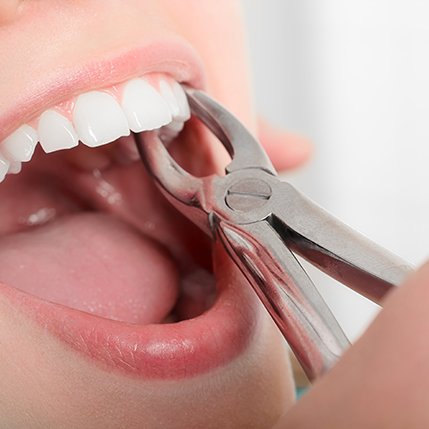Tooth Extractions – Catonsville, MD
Ensuring Better Oral Health For the Future
Are you dealing with an infected, broken, or partly erupted tooth? You’ll want to consider removal work if that’s the case; the damaged part of your grin won’t benefit your mouth now. The good news is that Advance Dental Clinic offers top-tier tooth extractions in Catonsville! With our help, you can get rid of the teeth that put your smile at risk. Learn more about the process by reading below or book a visit today.
Why Choose Advance Dental Clinic for Tooth Extractions?
- Sedation Dentistry for Patients of All Ages
- Same-Day Emergency Dental Appointments Available
- In-network for Most PPO Dental Plans
Reasons Why Tooth Extractions are Necessary

Rest assured that our practice doesn’t suggest tooth extractions lightly. These removal procedures are a last resort, as we’d rather perform other work – root canals, dental crowns, etc. You’d then get to keep your tooth and use it to bite, chew, and smile.
Given these truths, tooth extractions are only necessary when a tooth (or teeth) can’t be saved. We’ll only perform them if you suffer one (or more) of the following issues:
- Your tooth has decayed too much to be restored with a filling or crown
- Tooth trauma has damaged your enamel beyond repair
- Gum disease has weakened the bone supporting your tooth
- Your mouth needs more room for a new denture
- A stubborn baby tooth won’t fall out and blocks an adult one
The Process of Removing a Tooth

At your consultation visit, Dr. Bemani will assess whether and/or how to extract your affected tooth. She’ll then use her findings from this exam to confirm if you need a simple or complex removal.
Our team will perform a simple extraction if the tooth is visible. In that case, we’ll first numb the treatment site with an anesthetic so you don’t feel pain. We’ll then rock your tooth back and forth with dental forceps until it separates from your gums.
If the tooth hasn’t fully erupted, you’ll need a complex extraction. This second option requires that we make an incision in your gums (after numbing them, of course). Once the cut is made, we’ll divide and remove your tooth in sections to reduce bone loss. Our team will then sew the incision closed.
After an extraction (simple or complex), we normally start planning how to replace the tooth. This step ensures you won’t suffer long-term oral health issues.
Tooth Extraction Aftercare

While your tooth extraction should go smoothly, you’ll still need time to recover. The process leaves the mouth sore and achy, at least once the anesthetic wears off. That means you should use these post-op instructions while you heal:
- In the first 24 hours after the extraction, clean the treatment site with saltwater rinses.
- Don’t chew near the extraction site while it’s still healing.
- To manage post-extraction soreness, use store-bought pain relievers according to instructions.
- Since suction can dislodge your blood clot, don’t drink from a straw for a few days.
- Don’t smoke tobacco or spit while healing; doing so would cause recovery delays.
Assuming you follow the tips above, you’ll heal well from your extraction. You can then consider tooth replacement – a service that would restore your smile, bite, and much more!
